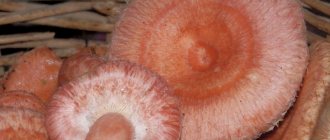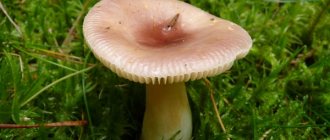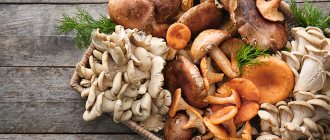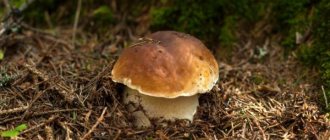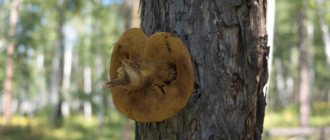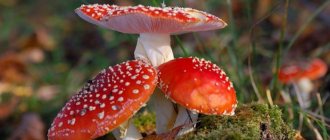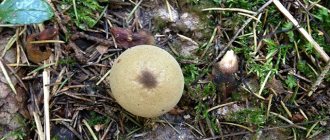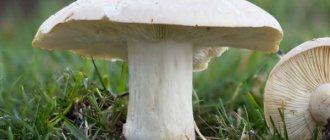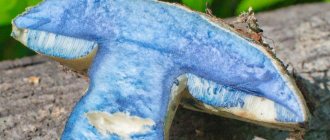Mushrooms are a tasty and healthy product, widely used in domestic home cooking. Housewives know hundreds of recipes for preparing these gifts of nature. Of course, specimens grown in natural forest conditions are tastier: they are richer in both smell and taste, and can be stored longer. However, in big cities, people more often use industrially grown mushrooms.
The most common varieties are champignons and oyster mushrooms. However, when stored in the refrigerator, oyster mushrooms often develop a white coating, which many housewives mistake for mold and simply throw the mushrooms in the trash. In our material you will find answers to questions about whether a white coating always indicates the beginning of mold development, why it appears and what to do if you find it.
What is white plaque and why does it appear?
A white coating can be found at the base of the stem, on the surface of the cap and in the depths of the mushroom. However, it is worth carefully examining the oyster mushroom: if its body is clearly fresh, the flesh is elastic, the cap is intact, the surface is without signs of darkening or sliminess, and the smell is real mushroom without unpleasant notes of acidity or spoilage, then you don’t have to worry - this is not mold, but mycelium.
The thing is that during harvesting, small particles of mycelium remain on the mushroom and as soon as it “warms up”, the growth process begins. White fluff on the surface is nothing more than a sign of mycelial growth.
In terms of smell and taste, mycelium is no different from mushroom, but the main thing is that it does not pose any health hazard and such mushrooms can be safely used in cooking.
However, we should not forget that white coating can also mean the appearance of real mold. This product is hazardous to health and must be disposed of immediately. If the white coating is mold, then when examining the mushroom you will definitely find other signs of the presence of spoilage. First of all, you will feel an unpleasant odor; most likely, in places of plaque, the surface of the mushroom will not be soft and velvety, but wet and unpleasantly slippery. If these signs are detected, there is no doubt: the product has deteriorated and is categorically unsuitable for food.
Choice when purchasing
First of all, when purchasing, you should inspect the mushroom for damage. It should have a generally good shape, white color without yellow spots . The presence of cracks, wormholes, even small ones, indicates that the product is not fresh.
The next thing you should pay attention to is the length of the leg. Not all buyers are aware of this nuance, and it becomes clear why this happens. Some people enjoy the specific flavor texture of the drumstick, while others take it for granted. Ideally, the stems should be cut off or very short, as this part of the oyster mushroom contains few nutrients and has a harsh taste.
You need to choose young mushrooms. To determine the age, just break off a small piece from the cap. The presence of white and juicy pulp confirms the freshness of the mushroom, and if the structure is fibrous, then this mushroom is stale and should not be purchased.
Important! The smell is key ; it should not be unpleasant or pungent.
Reasons for appearance
The main reason for the appearance of plaque (both harmless and harmful) is improper storage: during transportation, in a store or at home. If oyster mushrooms are kept in a plastic bag for a long time without air access, they quickly begin to deteriorate. Mushrooms will also develop plaque if they have been in high humidity conditions for some time.
We talked about how to properly store oyster mushrooms here.
By the way, plaque can also form on overgrown mushrooms. This coating is unaesthetic, but also harmless: it can be washed off and the product can be used in food. However, it is better to purchase young specimens: they are more tender, more aromatic and tastier.
Bacterial lesions
The topic of bacteriosis is overblown on the Internet, especially on forums.
Any infectious lesion of dead sprouts is unknowingly declared bacteriosis. And many beginners also think that they brought it with mycelium.
There is a separate article about real bacteriosis, which is caused by bacteria of the genus Pseudomonas. If you click here, it will open in a new window.
And I will tell you what happened to this sprout in the image, why it is moldy.
At first there was a lack of moisture - the mushroom in the center was dry, with a lifeless brown cap.
The two mushrooms above and slightly to the left began to develop later, when the moisture was raised.
But they raised it too high, or too quickly.
So they turned the caps up and exposed the plates so that they could evaporate their own liquid.
But the changes destroyed them and the splice died. Condensation began to settle on this dead mass, and mold grew on it.
Is it possible to eat?
So, the white coating in the form of mycelium is not dangerous to health, so such mushrooms can be eaten after washing and boiling well.
If, in addition to plaque, there is at least one more sign of spoilage or mold, then it is not worth the risk: it is safer to throw away such fruits.
How to deal with mold in mushroom blocks
Beginners think that there are chemical preparations to combat Trichoderma in mushroom blocks. If the defect occurs as a result of improper steaming or poor quality of raw materials, then chemistry will not help. The mycelium of brilliant green, like oyster mushrooms, is killed by one type of reagent - they are called fungicides. And you won’t be able to add them to the plant mass. They treat the premises.
To get rid of a problem, you need to know its cause. There are three main ones, I will list them starting from the most common:
Poor quality heat treatment of raw materials
If brilliant green penetrates deep into the entire mass
There may be several reasons, and often two or even all three occur simultaneously:
- the processing technology was violated in terms of time and/or temperature,
- the substrate has high humidity,
- pH (рh) below 7mi.
The faster mold invades a briquette containing processed raw materials, the greater the deviations from the technological processing regulations.
The most critical case is when overgrowth is not observed at all, and the grains of oyster mushroom mycelium are covered with a gray-green coating. As a rule, the quality of the mycelium has nothing to do with it - it’s just that, first of all, the fungus begins to occupy the boiled grain, there is easily digestible nutrition there.
And then he switches to husks or straw that are poorer in nitrogen.
How to fix
- change the regulations for processing plant raw materials. More details here;
- measure the pH of the substrate, maintain it at an optimal level of 7.8-8.5. The growth of mold mycelium is inhibited at a pH above 8, but oyster mushrooms can still withstand this range. Although, at a pH above 9, inhibition of its growth begins; — Keep the sowing room clean, create excess pressure there, so that spores of harmful microorganisms will not get into the processed raw materials on the sowing table.
Microclimate disturbance during incubation
More often it leads to infection only in the subfilm layer.
Incorrectly designed ventilation, temperature fluctuations in the chamber, create a large temperature difference between the subfilm layer and the internal contents of the bag, which causes an outflow of water from the center to the subfilm.
How to avoid unwanted plaque?
It is best to consume mushrooms on the first day after being collected in the forest or purchased in a store. In this case, the quality of the fruit will remain 100%. Unfortunately, this is not always possible, especially when it comes to processing a large batch of products. If so, then you need to take care of proper storage:
- Do not store oyster mushrooms in polyethylene, but only in containers that allow air to pass through: preferably a pan covered with a dish towel.
- can be stored in the refrigerator for no more than 10 days, outside the refrigerator (in a cold and dry place) for no more than 5 days;
- place oyster mushrooms on the lowest shelf of the refrigerator and maintain the temperature no higher than +2 °C;
- Before cooking, the fruits must be cooked.
We also recommend that you read the article: “Storing mushrooms at home.”
Nutritional value of fruits
All of the listed microelements are necessary for the proper functioning of vital systems of the body, primarily the cardiovascular and gastrointestinal tract.
The high value of the product allows mushrooms to replace all kinds of vegetables and even meat and seafood, which is very attractive for vegetarians, as well as those who adhere to religious, health or sports diets. Another huge advantage of oyster mushrooms is that even a small amount of fruit eaten quickly makes you feel full, although the mushrooms themselves are low in calories - only 43 kcal per 100 grams of raw product.
The chemical composition of the product has medicinal properties; decorative cosmetics, pharmaceuticals, as well as all kinds of tinctures and extracts used in alternative medicine are created on the basis of mushrooms.
It is important to know! People concerned about their health should know that only a few varieties of oyster mushrooms are healthy, and some of them are considered conditionally edible, which means they can cause serious food poisoning. If the mushroom picker is not confident in his knowledge, it is worth preparing in advance for the outing and studying what the safest and most popular, edible members of the family – oyster mushrooms – look like. The rest are not worth collecting. If you didn’t find it in the forest, you can find it in the nearest store.
Symptoms of poisoning
You can be poisoned by both freshly prepared and canned oyster mushrooms. Depending on the food that caused the poisoning, the symptoms will be different.
If intoxication is caused by the consumption of improperly preserved fruits, then this will be expressed in:
- strong and sudden increase in temperature;
- the occurrence of nausea and vomiting;
- diarrhea;
- convulsions and confusion that developed against the background of dehydration due to incessant vomiting.
If poisoning occurs as a result of consuming canned food affected by botulism (developed due to a violation of the preparation and storage technology), then along with nausea and vomiting the following signs will appear:
- increasing pain in the navel area;
- temporary visual impairment (blurred images);
- painful swallowing;
- increasing joint and muscle pain.
If poisoning occurred as a result of eating fruits that grew in environmentally unfavorable conditions and were saturated with all kinds of “chemicals,” then the picture of intoxication will be completely different, more vivid and more severe. Symptoms will be:
- attacks of severe nausea;
- profuse vomiting;
- increased drowsiness;
- headache;
- feeling of severe tightness in the back of the head.
The effect of botulinum toxin on the body
The most dangerous is considered to be intoxication caused by the penetration of such a microbe into a mushroom dish. This occurs if the rules for preparing oyster mushrooms before preservation are not followed. The impact of bacteria on the body is dangerous because it can lead to complications in the form of dysfunction of the liver, myocardium, and urinary system. If a person becomes ill with botulism, the following symptoms join the signs of poisoning:
- Severe discomfort in the abdominal area.
- Decreased vision. The patient's vision is blurry and spots flash before his eyes.
- Difficulty swallowing.
- Pain in the muscles.
conclusions
- White coating on oyster mushrooms when stored in the refrigerator can be harmless.
- Harmless plaque is sprouted mycelium that can be eaten.
- If the white coating is mold, then there will certainly be additional signs of spoilage: an unpleasant odor, changes in the surface, stains, etc. Such mushrooms should absolutely not be eaten.
- Oyster mushrooms must be boiled or well-fried before eating.
- Symptoms of oyster mushroom poisoning depend on the form in which the product was consumed.
Intoxication with products grown in artificial conditions
But even those who buy oyster mushrooms in the supermarket do not have a complete guarantee that they will be able to avoid poisoning. The quality of the product depends on the integrity of the manufacturer. Failure to follow certain rules can make the product poisonous. Is it possible to get poisoned by oyster mushrooms bought in a store? Yes, and this happens under the influence of the following circumstances:
- Adding large amounts of fertilizers and other chemicals to the soil.
- Growing products in areas located near the roadway or plant. Mushrooms are able to absorb exhaust gases and fumes of toxic substances.
- Failure to follow the rules for preparing pickled or salted oyster mushrooms.
Why oyster mushrooms are useful: properties of the mushroom
Regardless of where oyster mushrooms grow - in the wild on a stump or in a greenhouse on a substrate, their positive properties do not change.
And before looking for disadvantages in such tasty, affordable and easy-to-prepare mushrooms, let’s dwell on their clear advantages and how they are useful for humans.
Energy value
Oyster mushroom is a low-calorie product, which is rightfully considered a dietary product not only for its small amount of calories: 38 kcal per 100 g of fresh mushrooms and 80 in the same amount cooked without oil.
Of these, there is only 0.3 g of fat, and 6.5 g of carbohydrates. For comparison, buckwheat contains as many as 62 g of carbohydrates and 3.3 g of fat. The carbohydrates in these mushrooms contain sugars, but not glucose or sucrose, but lactose, glycogen and mycosis. If the latter can only be found in other mushrooms, then lactose is one of the main substances contained in milk, as well as glycogen, which is considered a substance of animal origin.
In addition, oyster mushrooms can be consumed by people with any type of diabetes, since oyster mushrooms do not affect blood sugar levels in any way.
At first glance, there is not much protein in them, only 2.5 g, but its composition is close to that of animals, and not of plants. For example, it contains the essential amino acids lysine and phenylalanine.
At the same time, oyster mushrooms are a very satisfying product that dulls the feeling of hunger for a long time due to the fiber in their composition.
Dietary product
Fiber in our body promotes faster digestion of food, cleanses the intestinal walls of mucus and putrefactive formations, and promotes cell renewal.
However, in oyster mushrooms, unlike whole grain bread, it does not consist of cellulose, but of chitin - the same one that we see on the shells of crayfish and lobsters. It would seem to be a very solid substance, but in this “plant” form, chitin helps maintain normal microflora, as it feeds bifidobacteria. In addition, it restores damaged gastrointestinal tissue.
Vitamin-mineral complex
A serving of stewed oyster mushrooms contains 18% of the daily requirement of potassium, which improves cardiovascular and brain activity. And the same amount of zinc - an indispensable element in order to feel vigorous and full of energy and enjoy beautiful hair and nails.
In addition, oyster mushrooms contain phosphorus, magnesium and iron and are one of the lowest calorie sources of vitamins B1, B2 and D2, most of which are found in bread.
Taste qualities
When talking about the benefits of oyster mushrooms, one cannot fail to mention their taste. These mushrooms have a distinct taste and aroma. They make julienne and salads, all kinds of fillings and stews equally tasty. When properly prepared, oyster mushrooms will improve the taste of any dish, cold or hot.
In addition, frozen oyster mushrooms do not lose any of their taste, but more on that later, but for now let’s look at the harm oyster mushrooms can bring to our body.
